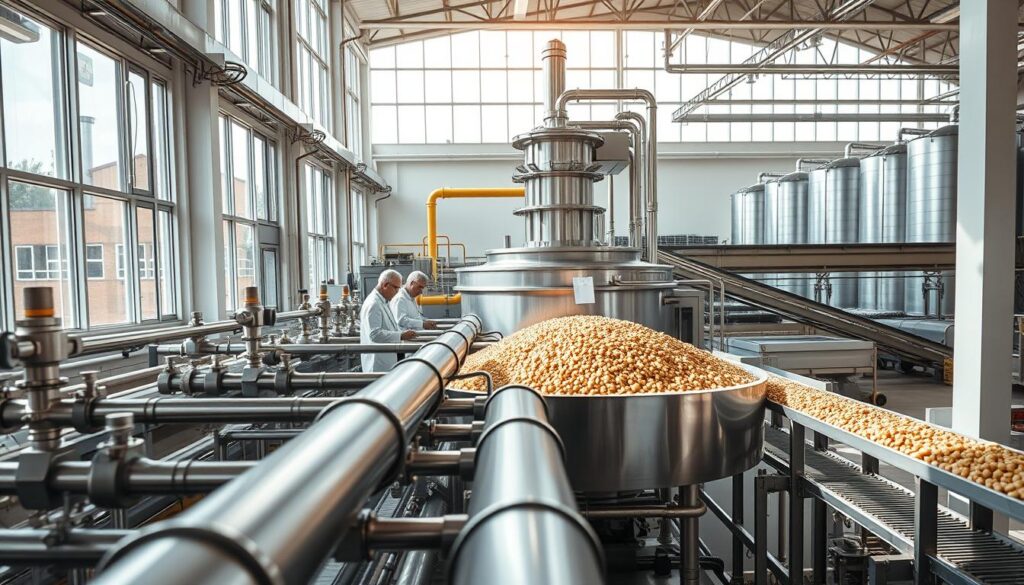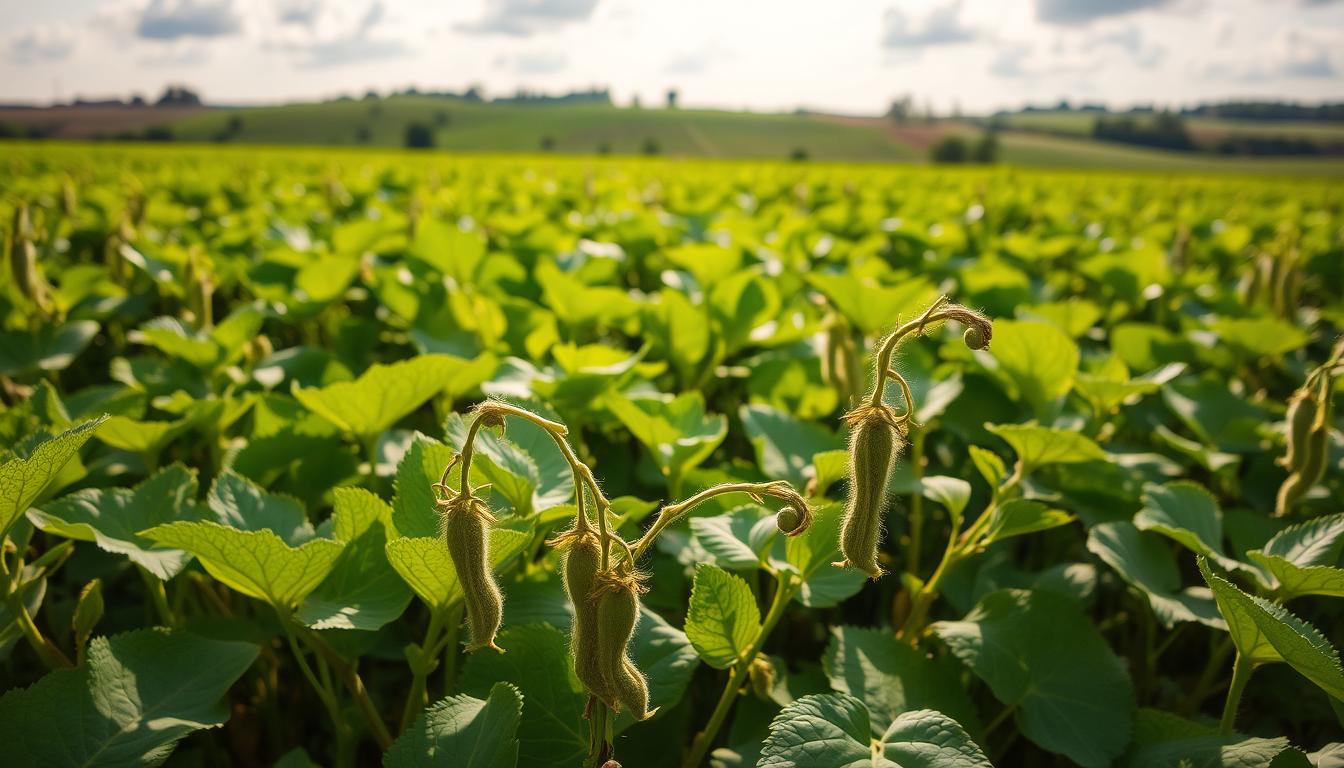Have you ever wondered how a small seed like the soybean could hold such big nutritional power? Soybeans, a type of legume, have been a cornerstone of human nutrition for centuries, especially in East Asian cuisines. Packed with high-quality protein and beneficial compounds like isoflavones, soybeans offer a wealth of health benefits that make them a standout in the world of nutrition.
From traditional dishes like miso and tofu to modern health trends, soy has become a global phenomenon. This guide dives into the nutritional profile of soybeans, their historical significance, and their impact on modern diets. Whether you’re a health enthusiast or just curious about adding more plant-based options to your meals, this guide will cover everything you need to know about soybeans and their role in a healthy lifestyle.
Key Takeaways
- Soybeans are a nutrient-rich legume with a long history in East Asian cuisine.
- They provide high-quality protein and beneficial compounds like isoflavones.
- Soy has a significant impact on global diets, from traditional to modern health trends.
- Soybeans support heart health and may reduce the risk of certain cancers.
- Incorporating soy into your diet can offer numerous health benefits.
Introduction to Soybeans and Legumes
Soybeans are a cornerstone of global agriculture, serving as both a vital food source and an essential industrial product. Originating in East Asia, they have become a key crop in many countries, including the United States, where they are cultivated on a massive scale.
As a crop, soybeans are incredibly versatile. They are used in various food products, from tofu and soy milk to sauces and snacks. Beyond the food industry, soybeans are also utilized in industrial applications, such as biofuels and plastics. This dual role makes them a significant contributor to both nutrition and manufacturing.
| Use of Soybeans | Examples |
|---|---|
| Food | Tofu, soy milk, edamame, and soy sauce |
| Industrial Products | Biodiesel, plastics, adhesives, and printing inks |
“Soybeans are a true marvel of agriculture, offering solutions for both sustenance and industry.” – Agricultural Research Service
The United States is one of the top producers of soybeans globally, with the crop playing a crucial role in the country’s agricultural economy. Cultivation typically occurs in the Midwest, often referred to as the “Soybean Belt,” where the climate and soil conditions are ideal for growth. Soybeans are planted in the spring and harvested in the fall, with each plant producing numerous pods containing the valuable beans.
The processing of soybeans involves several steps, from cleaning and drying to cracking and extracting oil. The remaining meal is used as high-protein feed for livestock. This comprehensive utilization ensures that almost every part of the soybean is put to use, minimizing waste and maximizing efficiency.
Soybeans have also found their way into traditional cuisines worldwide, adapting to various cultural tastes and culinary practices. Their nutritional value and versatility have made them a staple in many diets, contributing to their global popularity.
In summary, soybeans are a multifaceted crop with a rich history and wide-ranging applications. Their significance extends beyond the dinner table, impacting industries and economies on a large scale. This section has provided an overview of soybeans as a vital crop and product, setting the stage for a deeper exploration of their nutritional benefits and historical roots.
Nutritional Profile and Health Benefits
Soybeans are a powerhouse of nutrition, offering a unique combination of macronutrients and micronutrients that support overall health. With their high protein content, balanced carbohydrates, and healthy fats, they provide sustained energy and essential nutrients for the body.
Protein, Carbs, and Healthy Fats
A 100-gram serving of boiled soybeans contains about 18.2 grams of protein, making them an excellent source of plant-based protein. This protein is a complete protein, meaning it contains all nine essential amino acids that the body cannot produce on its own. This makes soybeans an ideal choice for vegetarians and vegans looking to meet their protein needs.
Soybeans also contain 8.4 grams of carbohydrates per 100 grams, which are primarily in the form of fiber and natural sugars. The fiber content aids in digestion and promotes a feeling of fullness, while the healthy fats, including monounsaturated and polyunsaturated fats, support heart health.
Vitamins, Minerals, and Isoflavones
Beyond macronutrients, soybeans are rich in essential vitamins and minerals. They are a good source of iron, manganese, and vitamins like riboflavin (B2) and folate (B9). These nutrients are crucial for energy production, immune function, and overall well-being.
One of the most notable compounds in soybeans is isoflavones, a type of phytoestrogen. Studies have shown that isoflavones may help reduce the risk of certain cancers and alleviate menopausal symptoms. For example, consuming about 68 grams of soybeans daily provides 135 mg of isoflavones, which has been linked to these health benefits.
Overall, the nutritional profile of soybeans makes them a valuable addition to a healthy diet. Whether consumed as tofu, soy milk, or in other forms, soybeans offer a wealth of benefits that can enhance both nutrition and overall health.
Understanding soybeans legumes
Soybeans, a member of the legume family, are scientifically classified as Glycine max. This classification highlights their botanical identity as a seed that transforms into a nutrient powerhouse. As a plant, soybeans are cultivated worldwide for their versatility and nutritional value.
Key Nutritional Components
The soybean seed is central to its nutritional profile. It evolves from a simple plant seed into a rich source of protein, fiber, and healthy fats. Soy flour, made from ground soybeans, is a popular plant-based ingredient used in baking and alternative products, offering high protein content and gluten-free options.
| Nutritional Component | Benefit |
|---|---|
| Protein | Complete protein with all essential amino acids |
| Fiber | Aids digestion and promotes satiety |
| Healthy Fats | Supports heart health |
| Isoflavones | May reduce cancer risk and alleviate menopause symptoms |

Various forms of soy, such as soya bean and soybean, are processed to retain nutrients. These forms are integral to both traditional and modern diets, making soybeans a cornerstone of global nutrition.
Soy Food Varieties and Culinary Uses
Soy food has become a staple in many cuisines around the world, offering a wide array of delicious and nutritious options. From traditional dishes to modern innovations, soy-based products have evolved to meet the diverse needs of health-conscious consumers.
Traditional Products: Tofu, Soy Milk & Soy Sauce
Tofu, a versatile soy product, is a cornerstone in many Asian dishes. It absorbs flavors beautifully, making it a favorite in stir-fries and curries. Soy milk, another traditional staple, is a popular dairy substitute, often fortified with calcium and vitamins for enhanced nutrition. Soy sauce, with its rich umami flavor, is an essential condiment in East Asian cuisine, adding depth to various dishes.
Modern Soy-Based Innovation
Today, soy foods are being reimagined to cater to modern tastes and dietary preferences. Plant-based meat substitutes, made from soy protein, are gaining popularity for their resemblance to traditional meat in texture and taste. Soy-based snacks, such as soy nuts and energy bars, offer convenient and healthy options for on-the-go consumers.
The evolution of soy products reflects a blend of tradition and innovation, making soy a timeless ingredient in global cuisine. Whether in the form of a classic tofu dish or a cutting-edge meat substitute, soy continues to inspire culinary creativity and support healthier lifestyles.

Soybean Processing and Oil Extraction
Transforming soybeans into valuable products like oil and meal involves a detailed process. This journey from seed to oil is crucial for understanding how these beans become essential ingredients in our diets and industries.
From Seed to Oil
The process begins with cleaning and drying the soybeans to remove any debris. Next, they are cracked to separate the hulls from the meat. The hulls are removed, and the soybean meat is flaked to prepare for oil extraction. There are two main methods: mechanical pressing and solvent extraction with hexane. Mechanical pressing is simpler but less efficient, while hexane extraction yields more oil and is widely used in large-scale operations.
| Extraction Method | Description |
|---|---|
| Mechanical Pressing | Uses a mechanical press to extract oil from flaked soybeans. |
| Solvent Extraction | Employs hexane to dissolve and extract oil from the flakes. |

Defatted Soybean Meal Applications
After oil extraction, the remaining soybean meal is rich in protein. This defatted meal is widely used as high-quality animal feed, particularly for poultry and livestock. It’s also utilized in the production of various food products and industrial applications.
| Application | Usage |
|---|---|
| Animal Feed | Provides essential protein for poultry and livestock. |
| Food Products | Used in manufacturing soy flour, protein isolates, and concentrates. |
| Industrial Use | Employed in biofuels, plastics, and other manufacturing processes. |
Technological advancements have made soybean processing more efficient. Modern facilities use less energy and solvents, reducing environmental impact. These innovations ensure that both oil and meal are produced sustainably, meeting the growing demand for soy products in food and industry.
Agricultural Practices and Environmental Considerations
Farming practices play a crucial role in balancing agricultural productivity with environmental preservation. Sustainable cultivation techniques are essential to minimize the ecological footprint of soybean farming.
Sustainable Cultivation Techniques
Modern farmers use methods like crop rotation and organic farming to reduce soil erosion and maintain fertility. These practices not only protect the environment but also ensure long-term soil health.
| Practice | Environmental Benefit |
|---|---|
| Crop Rotation | Prevents soil depletion and reduces pest buildup |
| Organic Farming | Eliminates synthetic fertilizers and pesticides |
| Conservation Tillage | Reduces soil disturbance and erosion |
Impact on Ecosystems and Nitrogen Fixation
Soybeans are a source of natural nitrogen fixation, enriching the soil and reducing the need for synthetic fertilizers. This process benefits the ecosystem by promoting biodiversity and supporting microorganisms in the soil.
The environmental impact of soybean cultivation is significant. While they provide a sustainable protein source for both humans and animals, large-scale production can lead to deforestation and habitat loss. For instance, the Midwest’s “Soybean Belt” has seen substantial land use changes, with over 81% of soybean-producing land concentrated in this region.

Innovative farming practices, such as precision agriculture and regenerative farming, address symptoms of environmental stress like soil degradation and water pollution. These methods aim to optimize resource use and minimize waste, ensuring soybean farming remains a viable and sustainable practice for future generations.
The Historical Journey of Soybean Cultivation
Soybeans have a rich history that dates back thousands of years. Originating in East Asia, they were first domesticated in central China around 7000 BCE. This marked the beginning of their journey as a vital food source and industrial product.
Ancient Origins and Cultural Significance
The early role of soybeans in traditional diets was significant. They became a staple in East Asian cuisine, valued for their nutritional benefits. Research during this period highlighted their health advantages, making them a cornerstone of many cultures.
Global Expansion and Trade Routes
The spread of soybeans beyond Asia began through ancient trade routes. They were introduced to the United States in 1804, where they quickly became a key crop. By the 19th century, soybeans were cultivated across the Midwest, known as the “Soybean Belt.”
| Historical Milestone | Details |
|---|---|
| Domestication | Central China, circa 7000 BCE |
| Introduction to the U.S. | 1804 |
| Civil War Use | Used as a coffee substitute |
Today, soybeans remain a crucial part of global agriculture, offering numerous benefits for both diet and industry. Their historical journey is a testament to their enduring value and versatility.
Soybean Research and Future Innovations
Recent advancements in soybean research are opening new avenues for improving health and agriculture. Scientists are exploring various types of soybeans to understand their effects on human health and the environment.
Recent Scientific Studies and Findings
Studies have shown that different types of soybeans can improve heart health and reduce the risk of certain cancers. For instance, consuming about 68 grams of soybeans daily provides 135 mg of isoflavones, which may help alleviate menopausal symptoms. Research also highlights soy as a good source of plant-based protein, making it ideal for modern diets focused on sustainability and health.
Advancements in Cultivar Development
In recent years, scientists have developed new soybean varieties that are more drought-tolerant, addressing a critical environmental condition. These advancements aim to improve yields, especially in dry seasons, ensuring farmers can maintain profitability. For example, in 2020, American farmers produced 4.14 billion bushels, a 16% increase from 2019, thanks in part to these innovations.
Looking ahead, ongoing research is expected to further enhance soybean varieties, making them even more adaptable to changing climates. These efforts will continue to position soy as a vital component of future agriculture and health.
Addressing Concerns and Potential Adverse Effects
While soy offers numerous health benefits, it’s important to address some concerns related to its consumption. Like any food, soy can have adverse effects in certain individuals, particularly when consumed in large amounts or by those with specific sensitivities.
Thyroid Function and Allergic Reactions
Some studies suggest that high intake of soy isoflavones might interfere with thyroid function, particularly in individuals with iodine deficiency. Allergic reactions to soy are relatively rare but can occur, especially in children. If you experience symptoms like hives, itching, or difficulty breathing after consuming soy products, seek medical attention immediately.
Digestive Challenges and Managing Soy Intolerance
Digestive issues, such as bloating or gas, are common due to soy’s high fiber content. For those with soy intolerance, opting for fermented soy products like miso or tempeh can be easier to digest. If you suspect a soy allergy or intolerance, consult a healthcare provider for proper diagnosis and treatment options.
Familial predisposition can play a role in soy sensitivity, so it’s crucial to monitor your body’s reactions and adjust your diet accordingly. Research from various articles highlights the importance of moderation and awareness when incorporating soy into your meals. By understanding these factors, you can enjoy the benefits of soy while minimizing potential risks.
Conclusion
In conclusion, soya stands out as a nutritional powerhouse with a rich history and versatile uses. From its origins in East Asia to its modern applications, soya has become a cornerstone of global cuisine and agriculture. Its high protein content, fiber, and healthy fats make it a valuable addition to a balanced diet.
While soya offers numerous health benefits, it’s important to consider potential risks. Moderate consumption is key, especially for those concerned about cancer or breast cancer. Research suggests that overconsumption might interfere with thyroid function or increase certain health risks.
Despite these considerations, soya remains a sustainable and healthy choice. Its adaptability in both traditional and modern dishes makes it a versatile option for diverse diets. By understanding both its benefits and risks, you can make informed decisions to enjoy soya as part of a nutritious and eco-friendly lifestyle.
